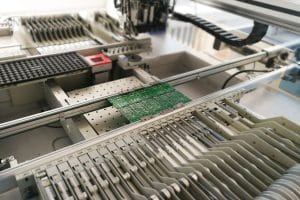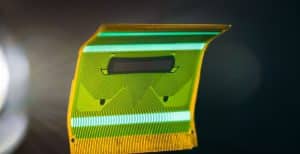Table of Contents
Introduction
As one of the most crucial components in electronic devices, PCBs have a very wide range of industrial and commercial applications nowadays. With the rapid development of technologies and products in consumer electronics, automotive, industrial control, medical devices, and various other industries, the demands and innovation pace for PCB advancements are constantly rising across major hi-tech sectors.
According to data from Prismark, the global PCB market exceeded $72.6 billion in 2022 and expects to reach $107 billion by 2027, showing a robust CAGR of 7.9%. The market demands show substantial growth for nearly all types of PCBs including single-sided, double-sided, multi-layer, HDI, flexible, and rigid-flex as well as some special metal-based PCB solutions.
Especially with the introduction of cutting-edge electronic products every year that feature more powerful, smaller footprint designs across smartphones, autonomous vehicles, robotic equipment, and other gadgets, this spurs more integration and improved performance requirements for PCBs to address thermal dissipation, signal integrity, and electromagnetic compatibility (EMC) noise suppression challenges. This article will provide an overview of various PCB technologies available today and demonstrate their typical applications in major industries to power the future of electronics.
Multilayer PCBs
As one of the most common PCB structures in use today, multilayer PCBs contain 3 or more conductive copper layers that are separated by dielectric substrate materials. These multiple layers allow greater component density and more complex circuity integration in a compact form factor. Some advanced multilayer boards may have up to 30 layers or even more for highly complex electrical systems.
With the benefits of miniaturization and reliability, multilayer PCBs now have become indispensable in a vast amount of applications. Some major industry sectors adopting multilayer PCBs are:
Consumer Electronics
Most modern consumer electronic gadgets employ multilayer boards to accommodate increased functionality in ever shrinking sizes, while still ensuring durability – ranging from smartphones, laptops, tablets, wearables, smart home devices, game consoles to all kinds of IoT gadgets. The number of layers vary between 4 to 12 typically depending on complexity requirements. Signal integrity and stable power delivery over multiple PCB layers are quite critical.
Automotive
Vehicles nowadays also packed with ever more sophisticated electronic systems like engine control units (ECUs), ADAS self-driving components, vehicle information and entertainment systems. Such complex electronics rely heavily on reliable and compact multilayer boards. The auto-grade PCBs meeting AEC-Q100 or IPC-A-610 qualification can ensure stable operations under vibrations and extreme temperatures.
Industrial Automation
Multilayer boards are utilized in all kinds of industrial control systems – such as programmable logic controllers (PLCs), sensors, robotic arms and various instrumentations. Rugged designs and noise reduction features allow reliable controls. High speed data buses integrating multiple components also require quality multilayer boards to maintain signal integrity.
Related Reading:

Rigid-Flex PCBs
Rigid-flex PCBs provide a perfect combination of rigid and flexible PCB substrates bonded together into one circuit solution. This allows designing firm contour-defining sections to mount components, while enabling flexible connections in between. Such mechanical agility coupled with reliable high density circuits make rigid-flex PCBs ideal choices for products requiring compact architectures subject to frequent movements and reconfigurations.
Some major applications benefiting from such kind of boards are:
Aerospace and Military Systems
Rigid-flex PCBs are prevalently used in weight and space sensitive airborne systems like satellites, rockets and various defense electronics. The boards can be bent to route connections matching the contours inside irregularly shaped housings while facilitating layer stacking in rigid zones. Ruggedized constructions also enable resilient performance under intense vibrations, shocks and temperature swings.
Wearable Devices
The emerging smart wearable device market – ranging from smart watches, smart glasses, health monitoring devices to augmented reality gears, also show substantial demands for flexible PCB solutions. Rigid-flex allows high density component mounting on rigid islands while achieving freedom of movement via narrow flexible connections in between. Such boards are perfect for fitting gadgets over curvilinear human bodies.
Other Applications
Other products that can benefit from employing rigid-flex boards include – drones, robots, portable medical systems, digital cameras, etc. The technology provides an optimal combination of density, performance, mechanical compliance, and embedded integration. As electronics march towards more seamless integration with daily living, rigid-flex PCB will have expanding adoption.
Related Reading:

Aluminum PCBs utilize aluminum metal as the substrate base material, usually coated with dielectric insulation layers on top and enabling direct component mountings. Such boards offer superior thermal conductivity compared to standard FR-4 boards, helping heat dissipation from high power electronic components. The metal base substrate also provides excellent EMI/RFI shielding performance.
Major applications of aluminum PCBs include:
LED Lighting
Powerful LED lighting elements can generate substantial heat loading during operations. Instead of FR-4, aluminum backed PCBs allow integrating lighting driver circuity and LED components into one thermally efficient module. The highly thermal conductive metal plate offers excellent heat dissipation from the soldered high wattage LED beads – ensuring brightness consistency and longevity.
New Energy Vehicles
Modern electric vehicles and hybrid EVs contains many high efficiency power electronics like traction inverters, DC/DC converters and battery charging systems. Such power electronics works at very high currents and needs reliable thermal management solutions. Aluminum PCBs prevent heat concentration thanks to dispersed substrate cooling – leading to improved EV motor controls and safe battery operations.
Power Electronics
Aluminum substrate boards also see widespread usage in all kinds of industrial power electronics, such as servo motor drives, renewable energy converters, power supplies etc. when these equipment goes into higher power ratings. Superior heat dissipation enables reliable performance under heavy loads. The insulating layer also allows circuitry to be safely mounted over exposed aluminum plates for most cost-efficient implementations.
Related Reading:

HDI PCBs
HDI stands for High Density Interconnect, representing a specialized PCB technology that allows ultra-fine circuit traces and high density component packing for highly compact and high performance electronic designs. HDI PCBs achieve miniaturization mainly through these core technologies:
– Fine Line/Space: line width/spacing down to 15μm/15μm
– Microvias: small vias with diameters below 150μm
– Thin dielectric build-up layers: typical thickness 100μm
Such tiny structures effectively multiply circuit routing layers vertically – enabling greater layout efficiency and component density similar to a larger board, now fitted into a very small footprint suitable for portable gadgets.
Typical HDI Applications Include:
Smartphones and Tablets
Slim and powerful handheld devices like iPhones, Android phones, iPads extensively employ HDI boards to integrate maximized functionality within miniaturized form factors to fulfill market demands. The boards pack elaborate RF circuits, high speed logic, multiple layer processor substrates and high density interconnects.
Automotive Electronics
Advanced driver assistance systems (ADAS) and next-gen electric vehicle (EV) controls also utilize HDI boards to optimize shapes and ensure quality signal transmissions. Auto-grade boards are specially customized to survive temperature extremes, vibrations and mechanical shocks in harsh under-the-hood environments.
Aerospace Avionics
Weight and shape sensitive airborne electronics systems highly favor HDI implementation to achieve satisfactory electronics functionality while minimizing physical bulk – including flight control modules, engine controls, navigational systems etc. Rugged, reliable constructions also withstand aviation environments.
Related Reading:

Other PCB Technologies
Besides the mainstream PCB types we have covered, there are quite a few other technology branches also seeing rising adoptions to address emerging application needs:
Metal Core PCBs
Metal core PCBs refers to boards using a base metal layer (aluminum or copper) laminated between insulation layers. The exposed metal core allows direct contact cooling, ideal for LED display screens and power conversion equipment.
IC Substrates & Packages
They represent PCB platforms to directly mount bare integrated circuits and connect pad electrodes to external pins or balls. Such substrates then get encapsulated into complete IC packages ready for integration onto electronics products. High pin count FPGA, GPU and ASIC chips often employ package PCBs.
Flex-Rigid Combinations
As the name implies, flex-rigid PCBs incorporate both flexible and rigid portions on the same circuit board. This allows mounting components on rigid zones while making dynamic interconnections through flexible areas – maximizing flexibility and reliability needed by robots, drones and portable devices etc.
Summary and Prospects
In summary, we have covered various common and emerging PCB solutions and their applications across major industries like consumer electronics, automotive, aerospace, industrial equipment and more. There are substantial demands for continual PCB innovations and quality improvements as enabling foundations to fulfill increasing complex, high performance and mission-critical system needs.
PCB technologies will undoubtedly continue flourishing in the future, with trends on:
- More layers, thinner substrates, finer lines and spaces
- Growing adoption of flexible and rigid-flex boards
- More widely used HDI designs
- Higher frequency materials and signal integrity
- Improved thermal management provisions
- Auto / aviation / medical grade certifications
And as a leading global PCB technology innovator and supply chain enabler, JHY PCB is dedicated to working with customers from all sectors to turn their design concepts into high-tech tangible products through our comprehensive PCB, PCBA, and value-added support services. Please inquire us to make things possible!
About JHYPCB
JHYPCB is a leading global PCB manufacturer with decades of experience in delivering reliable PCB and assembly solutions catering needs from prototype through high volume production scales.
Headquartered in China, our facilities have been accredited with ISO 9001 and IATF 16949 certifications along with UL, TS16949, and RoHS compliances. This ensures strict quality management principles across our SMT lines, mechanical assembly and final testing so that customers receive proven products made to work.
We offer a comprehensive range of PCB and PCBA services spanning:
- 24-hour Online Quoting & Ordering
- Multilayer, HDI, Flex / Rigid Flex PCB Prototypes
- SMT Assembly & Functional Testing
- Complete Box Build Assembly
- Consigned Components Service
- Instant DFM Check
Over years of diligent commitment to technology innovation, operational excellence, and customer service, JHYPCB has emerged industry-leading PCB solutions provider with a global clientele across North America, Europe, and Asia Pacific regions. Satisfied customers represent diverse background from startups through Fortune 500 companies across consumer electronics, automotive, industrial automation etc..
Please feel free to submit your inquiry to sales@pcbjhy.com for a competitive quote tailor-fitted to your specific demands. Our engineering team are ready to assist customers from initial concept discussions through all stages of manufacturing with the aim for delivering cost-effective and performance-driven PCB solutions!

















